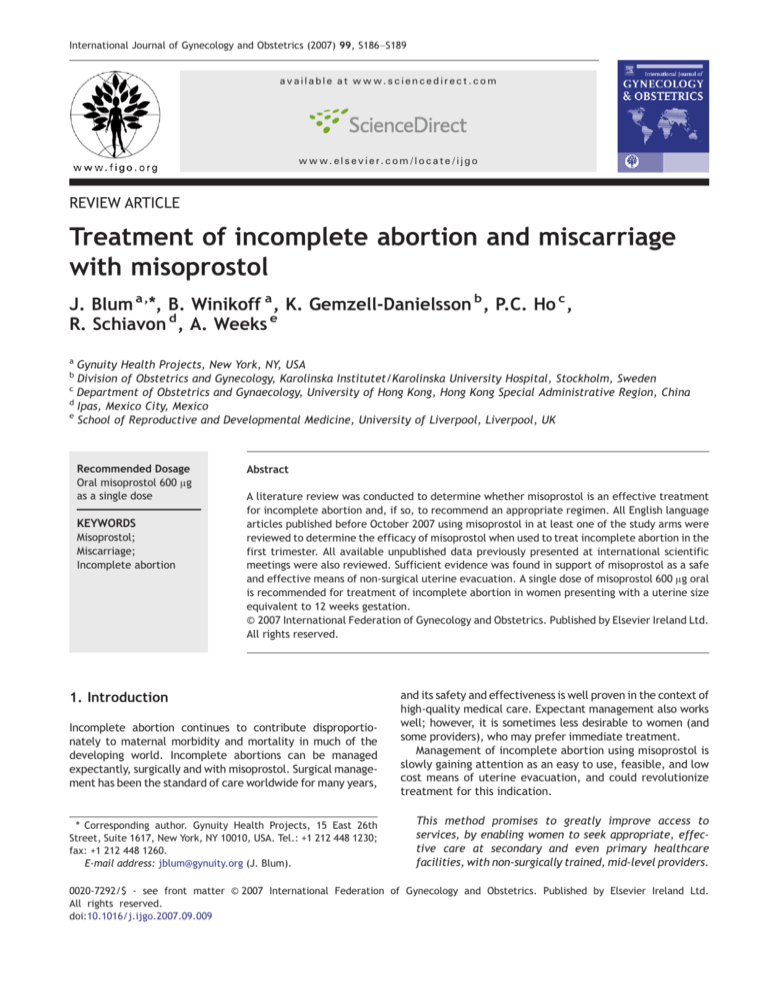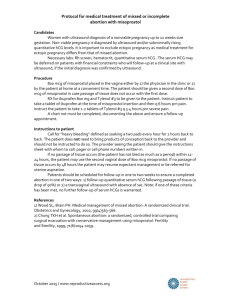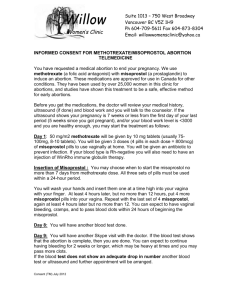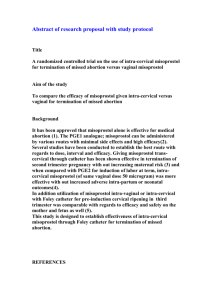
International Journal of Gynecology and Obstetrics (2007) 99, S186–S189
a v a i l a b l e a t w w w. s c i e n c e d i r e c t . c o m
w w w. e l s e v i e r. c o m / l o c a t e / i j g o
REVIEW ARTICLE
Treatment of incomplete abortion and miscarriage
with misoprostol
J. Blum a,⁎, B. Winikoff a , K. Gemzell-Danielsson b , P.C. Ho c ,
R. Schiavon d , A. Weeks e
a
Gynuity Health Projects, New York, NY, USA
Division of Obstetrics and Gynecology, Karolinska Institutet/Karolinska University Hospital, Stockholm, Sweden
c
Department of Obstetrics and Gynaecology, University of Hong Kong, Hong Kong Special Administrative Region, China
d
Ipas, Mexico City, Mexico
e
School of Reproductive and Developmental Medicine, University of Liverpool, Liverpool, UK
b
Recommended Dosage
Oral misoprostol 600 μg
as a single dose
KEYWORDS
Misoprostol;
Miscarriage;
Incomplete abortion
Abstract
A literature review was conducted to determine whether misoprostol is an effective treatment
for incomplete abortion and, if so, to recommend an appropriate regimen. All English language
articles published before October 2007 using misoprostol in at least one of the study arms were
reviewed to determine the efficacy of misoprostol when used to treat incomplete abortion in the
first trimester. All available unpublished data previously presented at international scientific
meetings were also reviewed. Sufficient evidence was found in support of misoprostol as a safe
and effective means of non-surgical uterine evacuation. A single dose of misoprostol 600 μg oral
is recommended for treatment of incomplete abortion in women presenting with a uterine size
equivalent to 12 weeks gestation.
© 2007 International Federation of Gynecology and Obstetrics. Published by Elsevier Ireland Ltd.
All rights reserved.
1. Introduction
Incomplete abortion continues to contribute disproportionately to maternal morbidity and mortality in much of the
developing world. Incomplete abortions can be managed
expectantly, surgically and with misoprostol. Surgical management has been the standard of care worldwide for many years,
⁎ Corresponding author. Gynuity Health Projects, 15 East 26th
Street, Suite 1617, New York, NY 10010, USA. Tel.: +1 212 448 1230;
fax: +1 212 448 1260.
E-mail address: jblum@gynuity.org (J. Blum).
and its safety and effectiveness is well proven in the context of
high-quality medical care. Expectant management also works
well; however, it is sometimes less desirable to women (and
some providers), who may prefer immediate treatment.
Management of incomplete abortion using misoprostol is
slowly gaining attention as an easy to use, feasible, and low
cost means of uterine evacuation, and could revolutionize
treatment for this indication.
This method promises to greatly improve access to
services, by enabling women to seek appropriate, effective care at secondary and even primary healthcare
facilities, with non-surgically trained, mid-level providers.
0020-7292/$ - see front matter © 2007 International Federation of Gynecology and Obstetrics. Published by Elsevier Ireland Ltd.
All rights reserved.
doi:10.1016/j.ijgo.2007.09.009
Treatment of incomplete abortion and miscarriage with misoprostol
At the same time, misoprostol for incomplete abortion and
miscarriage could decrease the burden on tertiary health
care facilities, and reduce costs to health care systems
worldwide. It could limit the burden on skilled surgical
providers, as well as reducing the need for surgical equipment
and supplies, surgical wards, sterilization and anesthesia.
Misoprostol treatment also has the additional benefit of being
highly acceptable to women as it is less medicalized and less
invasive than standard surgical treatment.
A review of studies of misoprostol for incomplete abortion/
miscarriage shows varying efficacy rates with dosages ranging
from 400 μg to 1200 μg [1–21]. Chung et al [1] studied 400 μg
misoprostol orally every four hours to a maximum dose of
1200 μg and assessed efficacy on the same day of treatment.
Overall success rates were low, with 50% of misoprostol users
requiring additional surgical care. Another study compared oral
and vaginal misoprostol with repeated 800 μg doses and
outcome assessment on the same day of treatment [2]. These
800 μg regimens showed slightly higher success rates (∼60%) [2].
Studies in which efficacy was assessed later (3 to 15 days
following initial treatment) have shown considerably higher
success rates, ranging from 60%–95% [1–24]. For instance,
Gronlund et al [4] compared 400 μg vaginal misoprostol to
expectant management and achieved a 90% success rate in the
misoprostol arm with assessment on days 8 and 14. Two studies
comparing a single dose of oral misoprostol 600 μg versus
600 μg × 2 doses (with a 4 hour interval) showed no difference
in efficacy between the two regimens [19–20]. Weeks et al [20]
compared 600 μg oral misoprostol to manual vacuum aspiration (MVA). In this study, the success rate with misoprostol was
96.3%, slightly better than MVA (91.5%) [4]. Three recent trials
also documented efficacy rates above 90% for misoprostol
when compared to MVA for treatement of incomplete abortion
[21–23]. There has been concern that non-surgical management could lead to higher rates of infection. However, in a
recent UK trial comparing medical vs. surgical vs. expectant
treatment for incomplete abortion, the lowest rate of
infection was in the expectant management arm [24].
If used for treatment of incomplete abortion, misoprostol
promises to have an important public health impact. Women
and health care systems worldwide could significantly benefit
from this non-invasive treatment option. In low-resource
countries, where infection, hemorrhage and uterine damage
are far too commonly reported as consequences of (poor)
surgical care, misoprostol treatment of incomplete abortion
would be a tremendous step towards reducing morbidity and
mortality due to abortion complications worldwide.
2. Contraindications
1.
2.
3.
4.
Known allergy to misoprostol or other prostaglandins.
Suspected ectopic pregnancy.
Unstable hemodynamic status or shock.
Signs of pelvic infection and/or sepsis.
3. Precautions
1. Women with an intrauterine device (IUD) in place should
have the intrauterine device (IUD) removed before drug
administration.
2. Coagulation disorders/ currently taking anticoagulants.
S187
4. Regimen
A single dose of 600 μg oral or 400 μg sublingual
misoprostol is indicated for treatment of incomplete
abortion and miscarriage for women presenting with uterine
size equivalent to a 12 week gestation.
600 μg oral misoprostol has been used to evacuate the
uterus safely for thousands of women participating in clinical
trials worldwide [18,20–23]. 400 μg sublingual misoprostol is
being used in several ongoing trials and has been shown to be as
safe and effective as the 600 μg oral dose [25]. At this time,
however, there is less evidence supporting use of this lower
dose regimen. The current evidence does not support the use
of repeated doses [18,19].
5. Course of treatment
The course of treatment is brief and essentially involves two
outpatient visits. At the first visit, the incomplete abortion
status should be confirmed by history and clinical exam and
eligibility for misoprostol assessed.
The crucial clinical findings are an open cervical os and a
uterine size less than 12 weeks of gestation.
Where available, ultrasound may be used as an additional
diagnostic tool if incomplete abortion status cannot be
confirmed with history and clinical exam. Information about
misoprostol management, possible side effects and success
rate should be given to the woman. Given the small risk of
retained uterine products following treatment, surgical
intervention may be needed to empty the uterus for some
women.
It is important to explain to women that the expulsion
can occur over several hours to several weeks and that
bleeding will most likely be heavy for about 3–4 days,
followed by light bleeding or spotting for several weeks.
Routine antibiotic coverage is not necessary and local
norms regarding antibiotic use should be followed. The
provider may determine that the woman requires antibiotic
coverage based on history or clinical exam.
Depending on the health care system and her wishes, the
woman can take the misoprostol either at the health facility or
at home. She should be given contact details and encouraged
to consult the facility or the provider about any questions or
concerns.
When used in studies, a single dose of 600 μg oral misoprostol
successfully evacuated the uterus in nearly all women. Given
that the method may fail in some women, it is recommended
that all women have a follow-up visit in 7–14 days during which
time clinical history and a bi-manual exam should enable the
provider to determine the absence of symptoms and that the
uterus is firm and well involuted. In cases of uncertainty, an
ultrasound examination may be needed to confirm a complete
expulsion.
Care should be taken not to over-diagnose “failed medical
management”; for instance, a “thickened endometrium”
is not a good predictor of the need for surgery. A decision
for surgical completion should be based on the clinical
condition of the woman and not on the ultrasound picture.
Surgical intervention is not recommended prior to 7 days
S188
after treatment unless medically necessary (i.e. for
hemostatic or infection control).
At the follow-up appointment, providers should give
contraceptive counseling and a suitable contraceptive method
if desired. Future research on at-home follow up may
eliminate the need for the follow-up visit at the health facility.
If the abortion is not complete at the follow-up visit and the
woman is clinically stable and willing to continue to wait for
her uterus to empty, it is acceptable practice to give her
another dose of misoprostol.
The regimen recommended in this chapter applies to
misoprostol use in incomplete abortion when the uterine size
is not larger than expected in a 12 week pregnancy; however,
the length of amenorrhea prior to starting treatment may be
longer than 12 weeks.
Misoprostol can be used when the uterus is larger than a
12 weeks' gestation; however, the regimen is different.
Typically, lower doses are needed for efficacy and safety
when the uterus is larger [26]
J. Blum et al.
6.5. Diarrhea
Diarrhea may also occur following administration of misoprostol but should resolve within a day.
6.6. Skin rash
Occasionally skin rash occurs after administration of misoprostol and should resolve within several hours.
Acknowledgment
This chapter was developed for a misoprostol expert meeting
at the Bellagio Study Center, supported by the Rockefeller
Foundation, Ipas, Gynuity Health Projects and the UNDP/
UNFPA/WHO/World Bank Special Programme of Research,
Development and Research Training in Human Reproduction.
Conflict of interest
6. Effects and side effects
Prolonged or serious side effects are rare
6.1. Bleeding
After administration of misoprostol, bleeding typically lasts up
to two weeks with additional days of spotting that can continue
until the next menstrual period. Women should be told to
expect to bleed heavily for 3–4 days and instructed to contact a
provider if any of the following occur: (1) if she soaks more than
two extra large (“maxi”) sanitary pads or local equivalent per
hour for two consecutive hours, (2) if she suddenly experiences
heavy bleeding after bleeding has slowed or stopped for several
days, (3) if she has bled like a normal period, but continuously
for weeks and begins to feel dizzy or light-headed.
6.2. Cramping
Cramping usually starts within the first few hours but may
begin as early as 10 min after misoprostol administration.
The pain may be stronger than that experienced during a
regular period. Non-steroidal anti-inflammatory drugs
(NSAIDs) or other analgesia can be used for pain relief
without affecting the success of the method [27].
6.3. Fever and/or chills
Chills are a common side effect of misoprostol but are
transient. Fever is less common and does not necessarily
indicate infection. An antipyretic can be used for relief of
fever, if needed. If fever or chills persist beyond 24 h after
taking misoprostol, the woman may have an infection and
should seek medical attention.
6.4. Nausea and vomiting
Nausea and vomiting may occur and will resolve 2 to 6 h after
taking misoprostol. An anti-emetic can be used if needed.
The authors do not have any conflict of interest.
References
[1] Chung TK, Cheung LP, Leung TY, Haines CJ, Chang AM. Misoprostol
in the management of spontaneous abortion. BJOG 1995;102:
832–5.
[2] Chung TK, Lee DT, Cheung LP, Haines CJ, Chang AM. Spontaneous
abortion: a randomized, controlled trial comparing surgical
evacuation with conservative management using misoprostol.
Fertil Steril 1999;71:1054–9.
[3] Pang MW, Lee TS, Chung TK. Incomplete miscarriage: a
randomized controlled trial comparing oral with vaginal
misoprostol for medical evacuation. Hum Reprod 2001;16:
2283–7.
[4] Gronlund L, Gronlund AL, Clevin L, Anderson B, Palmgren N,
Lidegaard O. Spontaneous abortion: expectant management,
medical treatment or surgical evacuation. Acta Obstet Gynecol
Scand 2002;81:781–2.
[5] Ngai SW, Chan YM, Tang OS, Ho PC. Vaginal misoprostol as
medical treatment for first trimester spontaneous miscarriage.
Hum Reprod 2001;16:1493–6.
[6] Demetroulis C, Saridogan E, Kunde D, Naftalin AA. A prospective
randomized control trial comparing medical and surgical treatment for early pregnancy failure. Hum Reprod 2001;16: 365–9.
[7] de Jonge ET, Makin JD, Manefeldt E, De Wet GH, Pattinson
RC. Randomized clinical trial of medical evacuation and
surgical curettage for incomplete miscarriage. BMJ 1995;311:
662.
[8] Pandian Z, Ashok P, Templeton A. The treatment of incomplete
miscarriage with oral misoprostol. BJOG 2001;108:213–4.
[9] Agostini A, Ronda I, Capelle M, Romain F, Bretelle F, Blanc B.
Influence of clinical and ultrasound factors on the efficacy of
misoprostol in the first trimester pregnancy failure. Fertil Steril
2005;84:1030–2.
[10] Bagratee JS, Khullar V, Regan L, Moodley J, Kagoro H. A randomized
controlled trial comparing medical and expectant management of
first trimester miscarriage. Hum Reprod 2004;19: 266–71.
[11] Creinin MD, Moyer R, Guido R. Misoprostol for medical
evacuation of early pregnancy failure. Obstet Gynecol
1997;89:768–72.
[12] Davis AR, Robilotto CM, Westhoff CL, Forman S, Zhang J. NICHD
Management of Early Pregnancy Failure Trial group. Bleeding
Treatment of incomplete abortion and miscarriage with misoprostol
[13]
[14]
[15]
[16]
[17]
[18]
[19]
[20]
patterns after vaginal misoprostol for treatment of early
pregnancy failure. Hum Reprod 2004;19:1655–8.
Graziosi GCM, Mol BW, Ankum WM, Bruinse HW. Management of
early pregnancy loss. Int J Gynecol Obstet 2004;86:337–46.
Henshaw RC, Cooper K, El-Refaey H, Smith NC, Templeton AA.
Medical management of miscarriage: non-surgical uterine
evacuation of incomplete and inevitable spontaneous abortion.
BMJ 1993;306:894–5.
Moodliar S, Bagrattee JS, Moodley J. Medical vs. surgical
evacuation of first-trimester spontaneous abortion. Int J Gynecol
Obstet 2005;91:21–6.
Muffley PE, Stitely ML, Gherman RB. Early intrauterine
pregnancy failure: a randomized trial of medical versus surgical
treatment. Am J Obstet Gynecol 2002;187:321–5.
Zhang J, Gilles JM, Barnhart K, Creinin MD, Westhoff C,
Frederick MM. National Institute of Child Health Human
Development (NICHD) Management of Early Pregnancy Failure
Trial. A comparison of medical management with misoprostol
and surgical management for early pregnancy failure. N Engl J
Med 2005;353:761–9.
Ngoc NTN, Blum J, Durocher J, Quan TTV, Winikoff B. Medical
management of incomplete abortion using 600 versus 1200 mcg
of misoprostol. Contraception 2005;72:438–42.
Blanchard K, Taneepanichskul S, Kiriwat O, Sirimai K, Svirirojana
N, Mavimbela N, et al. Two regimens of misoprostol for treatment
of incomplete abortion. Obstet Gynecol 2004;103:860–5.
Weeks A, Alia G, Blum J, Ekwaru P, Durocher J, Winikoff B, et al.
A randomized trial of oral misoprostol versus manual vacuum
aspiration for the treatment of incomplete abortion in
Kampala, Uganda. Obstet Gynecol 2005;106:540–7.
S189
[21] Shwekerela B, Kalumuna R, Kipingili N, Mashaka N, Westheimer
E, Clark W, Winikoff B. Misoprostol for treatment of incomplete
abortion at the regional hospital level: results from Tanzania.
BJOG (Sep 2007), (OnlineEarly Articles). doi:10.1111/j.14710528.2007.01469.x.
[22] Dao B, Blum J, Thieba B, Raghavan S, Ouedraego M, Lankoande
J, Winikoff B. Is misoprostol a safe, effective and acceptable
alternative to manual vacuum aspiration for postabortion care?
Results from a randomised trial in Burkina Faso, West Africa.
BJOG (Sep 2007), (OnlineEarly Articles). doi:10.1111/j.14710528.2007.01468.x.
[23] Bique C, Ustá M, Debora B, Chong E, Westheimer E, Winikoff B.
Comparison of misoprostol and manual vacuum aspiration for
the treatment of incomplete abortion. Int J Gynecol Obstet
2007;98(3):222–6.
[24] Trinder J, Brocklerhurst P, Porter R, Read M, Vyas S, Smith L.
Management of miscarriage: expectant, medical, or surgical?
Results of randomized controlled trial. BMJ 2006;332:
1235–40.
[25] Rakotovao JP, Blumenthal P, Diop A, Winikoff B. Misoprostol for
treatment of incomplete abortion in Madagascar. Oral presentation at XVIII Meeting of the International Federation of
Gynecologists and Obstetricians (FIGO); Nov 2006. Kuala Lumpur,
Malaysia.
[26] Gómez Ponce de León R, Wing D, Fiala C. Misoprostol for
intrauterine fetal death. Int J Gynecol Obstet 2007;99(Suppl 2):
S190–3.
[27] Tang OS, Gemzell-Danielsson K, Ho PC. Misoprostol: pharmacokinetics profiles, effects on the uterus and side-effects. Int J
Gynecol Obstet 2007;99(Suppl 2):S160–7.








